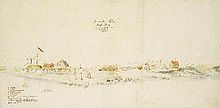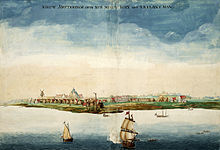Nieuw Amsterdam


Nieuw Amsterdam , German New Amsterdam , was the administrative seat of the Dutch colony Nieuw Nederland (New Netherlands) from 1624 to 1664 in the extensive area around today's Manhattan and was renamed New York after the conquest by the British .
history
Beginnings of Dutch settlement
Henry Hudson explored what is now New York Bay in 1609 and recognized the economic importance of the area, which he noticed because of its abundance of fur. Between 1611 and 1614, u. a. the Dutch Adriaen Block and Hendrick Christiansz the coastal strip. Over time, the Nieuw Amsterdam settlement developed there and became the most important settlement in the Nieuw Nederlands.
The purchase of Manhattan
For the first time in 1625 and then again in May 1626 , Peter Minuit , who was in the service of the Dutch West India Company (WIC) , a businessman born in Wesel and the son of Walloon religious refugees, reached Nieuw Nederland . In his role as governor of the colony, he had Fort Amsterdam built and was responsible for the management and expansion of the young settlement. He replaced Willem Verhulst, who was in charge of the colony in 1625. It is unclear whether Minuit himself (as tradition has it) initiated the barter, with which the locals, perhaps a branch of the Lenni Lenape , called the island “Manna-hatta” (hilly island) for goods worth 60 guilders resigned. This number comes from a letter from Peter Schagen to the West India Company: the traditional conversion into 24 US dollars, which uses a conversion rate from the 19th century, is not meaningful, as the amount cannot be easily deduced from the early 17th century can still be carried over to the present.
In any case, the purchase did not mean a transfer of ownership in the current sense, but rather the permission to use and settle the land in question together with the people living there. The purchase was also followed by a period of several years in which the Indian population had to be entertained and supplied with goods and food at the expense of the settlers.
Economy and further development
In order to improve the self-sufficiency of the settlement with food , farms ( Dutch boerderij ) were built outside the city limits - north of today's Wall Street , from which the name of the New York district Bowery derives. On February 2, 1653, Nieuw Amsterdam received city rights.

Capture of the city by the British
On August 27, 1664, shortly before the outbreak of the Second Anglo-Dutch Sea War , Nieuw Amsterdam was taken by a British expedition led by Richard Nicolls . Against the will of Petrus Stuyvesant , possibly because of his unpopularity, the Dutch surrendered without a fight. After the colony of Jacob , Duke of York (later King Jacob II), a brother of the English King Charles II , had been awarded, Nieuw Amsterdam was renamed New York .
literature
swell
- Berthold Fernow (Ed.): The records of New Amsterdam: From 1653 to 1674 Anno Domini . 7 vols. New York 1897, Baltimore 1976 (repr.) - (most important source edition on the history of Nieuw Amsterdams)
- Günther Schilder, Jan van Bracht: The origins of New York, commentary to the facsimile edition of “Nieuw Amsterdam” ofte nue Nieuw Torx bpt 'Eylant Man' and 'Afbeeldinge' van de stadt Amsterdam in Nieuw Nederlandt . Edition Seefeld, Zurich 1988.
Secondary literature
- Mariana Griswold Van Rensselaer: History of the City of New York in the seventeenth century . Vol. 1. New Amsterdam. New York 1909.
- Isaac Newton Phelps Stokes: The iconography of Manhattan Island 1498-1909 . 6 vols. New York 1915–1928.
- Russell Shorto: New York - island in the middle of the world. How the city of cities came into being. Rowohlt, Hamburg 2004. ISBN 3-499-62091-X
- Jaap Jacobs: New Netherland. A Dutch Colony in Seventeenth-Century America . Brill, Leiden 2005, ISBN 90-04-12906-5 .

